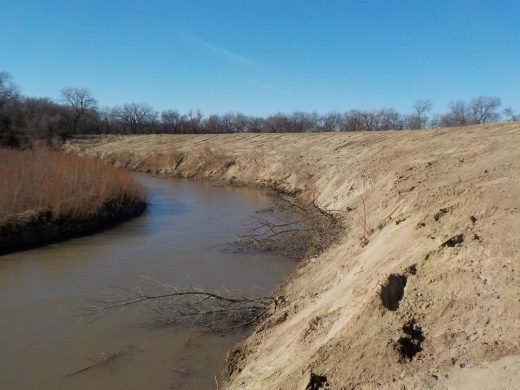Streambank erosion in Kansas is a serious concern, particularly upstream of reservoirs. In just one year, normal changes in rainfall or storm events lead to tons of soil from streambanks washing away into the water, headed downstream. That same sediment, when unchecked, also can diminish reservoir capacity, degrade wetland areas, and create problems with municipal water systems.
With approval from the Corps of Engineers and funding from both the Kansas Department of Health and Environment (KDHE) and Watershed Restoration and Protections Strategies (WRAPS), watershed specialist Ron Graber and his team partnered with a select few landowners along the Smoky Hill River interested in trying an untried method of streambank stabilization. This experiment is called a “woody revetment,” and, if successful, could save landowners tens of thousands of dollars – more, if there are several unstable streambanks on a property.
“[Landowners] know they have problems, they know they have issues, and in many cases, they don’t have a big bank account to pay for the solutions,” Graber said.
That’s a big problem, since the traditional solution for streambank stabilization is very expensive. This method, used in Kansas for close to 20 years, uses a windrow of rocks to secure the streambank. After reshaping the streambank, heavy equipment places the rock along the bottom of the streambank to strengthen it. Unfortunately, streams do not erode conveniently next to the highway, so the rock needs to be transported to the site – another difficult and costly addition to the process. For an 800-foot-long streambank, it could cost a staggering $64,000-$80,000 to stabilize it with traditional rock.

To ease this financial burden, the team collected local reinforcements … literally. Rather than transporting rock from miles away, Graber and his team made use of trees already on site. They removed and placed the trees along the streambank in a deep trench. The tree branches point out into the stream’s water, heading with the flow. The idea behind these woody revetments is that the trees’ roots keep the streambank stable while the angle of the tree branches trap and settle sediment in the stream, helping to reduce the downstream problems sediment can create.
Another big benefit to woody revetments? They cost about a quarter of the traditional rock stabilization, according to Graber.
Because this process is unique and experimental, only seven sites have been stabilized with this new woody revetment technique. The team won’t add more sites until they can determine woody revetments are successful or if the method needs adjustment. Kari Bigham, a professional engineer and Ph.D. student in K-State’s Department of Biological and Agricultural Engineering, is monitoring six of the seven sites to establish if the structures improve the streambanks’ physical stability, water quality, and the streams’ aquatic species habitat. These observations will help them evaluate what practices, if any, work best. Monitoring began last year and will continue through 2019.
This isn’t an exact science, and Bigham is the first to admit it.
“Streams are dynamic by nature. Sometimes one technique will work great on one site but works terrible on another. All we can do is try to figure out why, and then learn from it,” she explained. She believes that the current project, with its quantitative-type monitoring, is the best way to do this.
The next few years will help researchers determine if the woody revetments are as durable – and as effective – as other stabilization methods. Bigham said there are several methods to monitor if the revetments are helping to decrease sediment loss; these include taking repeated cross-section surveys through the stabilized reach, both pre- and post-construction. Researchers can also estimate past annual streambank erosion rates using aerial photographs. Over the four-year monitoring period, the team will also obtain water samples from the stream to see if there is a change in total suspended solids (TSS), which includes sediment.
None of this is a guarantee, however. Stream corridors are, well, fluid: watersheds have a lot of environmental variability, and every runoff event can cause varying amounts of erosion. The installation of more projects might make it possible to see a decrease in TSS over time, and Bigham believes a comparison study of woody structures versus rock structures would really be the “icing on the cake.”
Until then, however, Graber said that everyone just has to wait and see. “We’re not going to make it worse, but we may not make it better,” he said. Time will tell, and he hopes that in the next three years, this woody revetment process will prove to be a successful piece of the streambank stabilization toolbox.